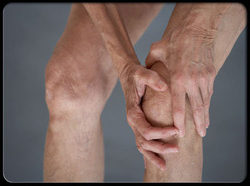

Osteoarthritis is the most common arthritis and involves degeneration of the joint cartilage. Risk factors include excess weight, family history, age, previous injury, and inactivity. The cartilage is the gristle you see on the end of the chicken leg bone. It is the slick cushioning surface on the ends of the bone and acts as a shock absorber with joint motion and with impact as in walking, running or jumping. The cartilage is tough, somewhat elastic and very durable. It does not have a blood supply so it absorbs its nutrition from the synovial fluid that surrounds the joint. When we use a joint, the pressure forces fluid and waste products out of the cartilage and when the pressure is relieved, the fluid together with the oxygen and nutrients seep back in. The health of your joints is dependent on using them. The cartilage can become frayed or split leaving the two surfaces of the opposing bones of a joint in contact with each other causing pain, stiffness and swelling. Sometimes small pieces of debris get caught in the joint causing pain. Over time, the opposing surfaces of the bone may become polished, a process called eburnation. As this happens the joint may become smoother and cause less discomfort, which is why sometimes the pain in your knee begins to decrease.
Individuals who have had a fracture near a joint, or who have a congenital malformation of a joint, or have an abnormal movement pattern even from an unrelated injury can develop an abnormal wear pattern and can develop early arthritis. The basic design of our joints is such that movement is what keeps them healthy. However, for example, if you have muscle weakness and/ or limited range of motion in your ankle it will change the stresses on your knee and hip and even our back.
http://www.moveforwardpt.com/symptomsconditionsdetail.aspx?cid=dbe9c9ba-7c47-4b77-8d44-a499cd81074a
Joint replacements are becoming increasingly more common, and provide relief from the pain of a degenerated hip or knee joint. Have you ever wondered how folks got along before total joint replacements? Did they just have to suffer through the pain? The answer may be according to this study that they did not need them. A recent study appearing in the National Academy of Sciences, using eburnation (remember the polished bone that occurs when the cartilage is gone) as an indicator for moderate to severe Osteoarthritis (OA) has shown that OA has more than doubled among Americans since 1940. The study compared knee joints of skeletons of individuals who lived in the 1880’s to early 1900’s (early industrial), those in the late 1900’s and early 2000’s (post-industrial) and prehistoric hunter-gatherers who lived between 6000 and 300 BCE.
Results from the study showed the prevalence of knee OA in the post-industrial skeletons was 16%, early industrial 6% (2.6 times less), and 8% for prehistoric. Their analyses concluded that the increased prevalence was not due to living longer and higher obesity rates, as is often assumed, but is instead due to reduced physical activity. In other words, osteoarthritis may be increasing because of our progressively sedentary lifestyle.
What does that say for the long-term joint health of the current generation of kids who spend more time inside on their electronics than outside playing?
You may have had an x-ray or MRI that shows you have arthritis. Remember as you are talking with your MD that those results will tell you what abnormalities may be present, but they do not necessarily tell you what is causing your pain. Studies have shown that severity of symptoms does not always correlate with the degrees of joint damage. For example, a person with significant degenerative changes may have fewer symptoms than another individual with mild joint degeneration.
http://www.moveforwardpt.com/radio/detail/osteoarthritis-of-hip-knee
Fact, the cartilage in your joints needs movement to obtain nutrition and stay healthy. That is why you wake up in the morning stiff and sore, but feel better as you move around.
If you start a new exercise program, mild muscle soreness is normal but you should not get sharp pain during or immediately following exercise. If you get severe joint pain the day after your exercise you may need to decrease the length or intensity of your exercises. Aquatic exercise is often good because it decreases the weight bearing effects of gravity.
Regular physical activity keeps your joints lubricated, which makes movement easier; it produces endorphins, which contribute to your overall sense of well being. You will benefit from a combination of low impact aerobics, strengthening, range of motion, and balance exercise.
http://www.moveforwardpt.com/symptomsconditionsdetail.aspx?cid=e46bb793-4cfa-48ec-9821-ceba2d4c54ab
A physical therapist can do an evaluation to see if you have limited range of motion, specific muscle weakness, or abnormal movement patterns that may be causing added stress on your joints. They can help you set up an exercise program to match your specific needs.